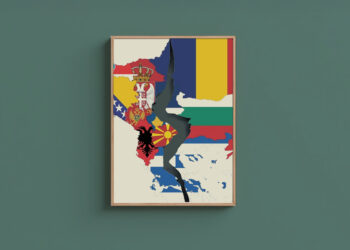In November 2016, the largest fire in Israel’s history consumed the forests surrounding Haifa. The Israeli authorities immediately suggested the possibility of a terrorist act. The Likud called it “the fire intifada.” In response, the Palestinian Authority’s Mahmud Abbas retorted: “The Israeli government exploits the fires to accuse Palestinians […] Yet, it’s our trees, the lands of our ancestors that are burning.” If Israel’s forests crystalize this tension, it is because afforestation played a discreet, yet important role in the history of appropriation of Palestinian lands.
Which forests are we talking about? European writers who visited Palestine in the 19th and 20th centuries describe natural vistas of captivating wild beauty. But some of them, such as Mark Twain in his book The Innocents Abroad talk about a poor nature and desolate, ugly vistas, at least in comparison with what is mentioned in the Bible.
At the end of the 19th century, the Palestinian landscape under Ottoman rule was made up of scrubland and deserts. Because of the dry, arid climate, the importance of shepherding to the economy as well as legislation imposed on the fellahin peasants taxing each tree, few could be found on the land. Hills were desolate except for a few fruit trees, mainly olive trees. In the end, WWI finished off what had remained of the trees since the Ottoman army had used them to keep warm or for railway tracks. However, during the British mandate period, other narratives paint another picture. In the book Land of Love and Fire (1927) the author Joseph Kessel compares between Arab and Jewish landscapes – people who appear rather languid and miserable as opposed to others who are active.
In effect, Jews had a different conceptualization of what the Holy Land should look like. New envoys had settled in Palestine since the rise of zionism at the end of the 19th century in eastern Europe. The new community would plant trees at sites overseen by a private association founded in 1901 called, in Hebrew, “Keren Kayemet Le’Yirarael” (KKL), and in English “The Jewish National Fund” (JNF). This foundation, which can be translated literally from Hebrew as ”the foundation for the establishment of Israel,” had been created as an executive branch of the zionist movement in Palestine, and was funded by Jewish organizations across the world.
A religious symbol
Why did a foundation hasten to plant trees? The answer to this question is often presented as a religious argument, as a sacred connection between the Jewish people and trees, and links a particular image of the natural landscape based on Torah mythology. In describing the land, the Holy Book mentions rich forests, noting about 12 different kinds of trees, which can be identified today as: stone pine, pistachio, sandalwood, oak, cedar, tamarisk, evergreen cypress, willow, juniper, white poplar, and acacia. Officially, it is justified as a reclamation of the Holy Land that the Palestinian people had left to decline. This is the image that “green zionism” promoted by the intellectual and educator Harun David Gordon(1856-1922) envisioned. “Green zionism” calls for harmony with the land of Israel, and to establish a spiritual connection with the land as a primary constituent, preceding any notions of Jewish political rule, although it’s difficult to ignore the nationalist and militaristic tone of the discourse. Gordonia, the youth movement born from the name Gordon in 1925 is the “mother” of a number of youth movements, the most well-known being the “Ha’noar Ha‘ovid ve’halomed”, the worker and educated youth movement, and included over 100,000 emboldened youth under the slogan “For Work, Defense, and Peace: Leaf and Rain,” recognizing that land is a necessity for “good” zionists to both own and defend it.
In the end, it’s worth noting that the descriptions of forests in the Torah don’t explain JNF’s affinity in its afforestation project for certain kinds of trees, like eucalyptus at first, and then stone pine. By the end of 1920, eucalyptus trees made up 80% of those planted by JNF. Stone pine is not mentioned even once in the Bible, yet it made up 98% of the trees planted in 1936. Today, stone pine trees make up a third of the number of trees in Israel forests.
Claiming land by planting trees
Planting trees was intertwined with the methodological implementation of a program that would kill two birds with one stone: seizing land then claiming to own it. The conditions of ownership are defined by the Ottoman Property Law of 1858, and form the legal base for the British mandate and then the Israeli occupation. The conditions are as follows: one must cultivate the land for three consecutive years in order to render possible the claim of ownership. In this way the cultivation of land made it possible for the JNF to safeguard possession of the land that it would buy. Starting in 1880, the eucalyptus tree was used in the first farms of the wetlands sold by Arab landowners at very moderate prices. This tree promotes the drying up and absorption of the swamps in the lowland areas, such as what happened in al-Khudayra region. Due to its fast growth and adaptability, it was commonly used and has an unshakeable connection to the earliest zionist efforts in the region, so much so that Palestinians often call them “Jews’ trees.”
The first big project for the JNF got under way in 1908 after buying 220 hectares near the Arab village of “al-Lud”. It was decided to establish an olive grove there in honor of Theodore Herzl, the founder of zionism. Arab workers who lived in the area were employed, constituting a cheap labor force to plant the olive trees. However, this angered the Jewish groups who insisted on the importance of employing “a Jewish labor force” on land they considered their own. The small olive trees – considered to be a Palestinian tree – were uprooted so that Herzl’s forest would correspond to a particular image. As such, Jewish workers planted stone pine instead. It was a low-cost tree with high nationalist value.
This is how a war of the Jewish tree against the Arab one was launched. In 1914, Elimelech Zogoroski, the chief agricultural engineer at the JNF commented about his 200 hectares near Kafr Dalib on the border road connecting the coastal plains to Jerusalem: “Indeed I chose this place in the view of all passers-by so that neighbors and passing travelers see that the Jewish people have reclaimed their land.” This is how trees became part of “militias,” guaranteeing for Jews a rooted presence on the land that precipitated the claim to ownership.
Extending the roots of one people by uprooting another
After World War I the tree project intensified. The British, who since the Balfour declaration in 1917, were officially in favor of the creation of a national home for the Jews in Palestine, supported the agricultural projects of the JNF. Additionally, they recommended planting trees as a way of fending off land erosion, to establish sand dunes, and help with hydraulic infiltration. It also responded to the demand for wood that their flourishing economy needed. As such, British and Jewish afforestation efforts intensified even more; the JNF undertook in a systematic way, the development of nurseries and farms relying on donations from the diaspora. A report written by Josef Weitz, director of the JNF in 1923, estimates the cost of afforestation by hectare of what he repeatedly calls “colonization.”
Afforestation efforts centered on al-Khalil (Hebron), the coastal plains, and cities that enjoy a symbolic value like Jerusalem where trees were planted in new neighborhoods, around public agencies, and historical and religious sites. As such, the onset of afforestation crossed central locales, which were then expanded and converged into patches of connected land under Jewish authority. This practice was utilized as a strategy of expansion to own land. After the 1948 war, these wooded lands fell inevitably under Israeli rule.
Following the creation of the Israeli state, afforestation was introduced as one of the pillars of the new nation. During the opening remarks at the second Knesset session in 1951, David Ben Gurion (head of the government at that time) asked the people to unite for the sake of “making the desert bloom,” announcing an actual propaganda campaign based on farm projects. “We have to plant hundreds of thousands of trees across an area of 5 million dunams, i.e. a quarter of the country. We have to cover all the mountains of the country, their slopes, all the plateaus and rocky lands unsuitable for agriculture, the coastal dunes and barren lands of the Negev with forests […] This is only the beginning of reforming the humiliation that generations have endured. The humiliation that the nation has endured. The humiliation that the land has endured. We have put all our professional strength for the country. ”
According to Ben-Gurion, the afforestation project is blessed with a double distinction; it creates numerous opportunities for work as well as creating a connection to the land for new arrivals. In his view, “planting trees is the only way to help the Jewish people develop a strong emotional relationship with the land.” In this way, afforestation plays a big role in the act of constructing a national identity and creating a sense of affiliation. It’s a way for those who join the national planting sites to gain the status of “indigenous people” by participating in building the country and to leave one’s mark on the land. Until the end of the 20th century, this propaganda of work continued to encourage Jewish migration from the former Soviet Union. In the end, what Ben-Gurion describes in his speech affected deep-rooted change in the landscape.
European forests for “a Jewish landscape”
Since the founding of the Israeli state, the JNF has planted 223 million trees, a quarter of them in the first ten years. The newly planted trees were evergreen varieties, different from those endemic types that existed all around Palestine before. The workers and most of the forestry engineers of the association came from Eastern Europe, and so their image of forests, how they should be formed and used derives from their previous experience. Not surprisingly, the stone pine forests that were established by the JNF resemble forests in Northern Europe.
By establishing themselves in Palestine, the Jewish community imposed an exclusive vision of the landscape. The construction of the state focused on creating a “Jewish” landscape that wouldn’t scare off the new arrivals. In this way, large swaths of forests gradually covered the arid hills. “Yaar ha‘kdoshim” (Martyr’s Forest), in which six million trees in memorial for the victims of the Holocaust of World War II were planted, was inaugurated in 1951. One can say that Jewish national identity is founded on trees. But deeply rooting one people necessitates the uprooting of another and the erasure of their landscape. To say nothing of dispossession and impoverishment, add to this the metamorphosis of the changing landscape that uproots a part of Palestinians’ identity.
The JNF’s afforestation project is reminiscent of another history. François Trottier, director of the Afforestation Association in Algeria wrote in his book Foresting the Desert and Settler Colonialism (1869): “Indeed, settler colonialism in the interior will not be possible without planting trees.” Travelers’ texts coming out of Algeria –also called “the country of thirst”– that conveys an accusatory discourse toward the indigenous inhabitants of neglecting to care for their lands. This discourse was used to legitimate the colonial intervention and to adapt and exploit occupied lands.
Diana K. Davis’s study “Environmental Myths of the French Occupation in the Maghreb” shows that the Afforestation Association at that time was behind the issuance of a new forestry law that put restrictions on pasturage, or to forbid it when it was considered “excessive.” And to encourage afforestation by recruiting local people in the planting projects. Then there came the comprehensive forestry law of 1903 that allowed for expropriation with the goal of afforesting lands considered to be a public benefit. At the end of the colonial era and despite these legal tools, only an insignificant amount of land was actually afforested.
According to Diana K. Davis, the establishment of areas in which pasturage or burning was forbidden was to limit traditional agricultural practices, and create in the long term sedentary nomadic populations. Attacking and seizing land, forcing out the indigenous population, and strong support coming from the French capital were in the end the components connected to the installation of settlers, making afforestation a weapon in the service of colonialism.
This article was originally published in French and Arabic by Orient XXI.








